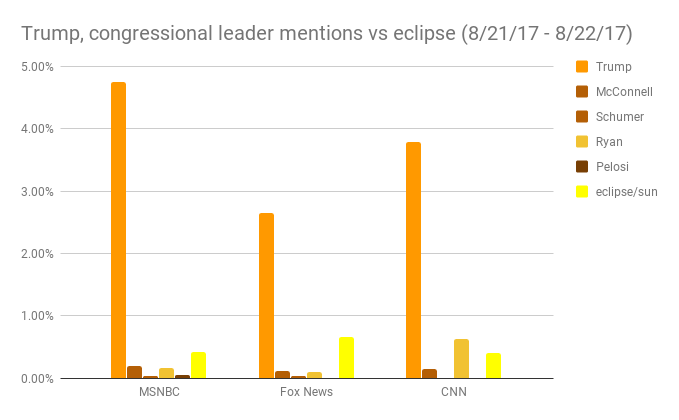A weekly round up on what’s happening and what we’re seeing at the TV News Archive by Katie Dahl and Nancy Watzman. Additional research by Robin Chin.
In this week’s TV News Archive roundup, we explain how presidential tweets are forever, show how different TV cable news networks summarized NFL protests via Third Eye chyron data, and present FiveThirtyEight’s analysis of hurricane coverage (hint: Puerto Rico got less attention.)
Wayback Machine preserved deleted prez tweets; PolitiFact fact-checks legality of prez tweet deletions (murky)
The Internet Archive’s Wayback Machine has preserved President Donald Trump’s deleted tweets praising failed GOP Alabama U.S. Senate candidate Luther Strange following his defeat by Roy Moore on September 26. So does the Pulitzer Prize-winning investigative journalism site ProPublica, through its Politwoops project.
Kudos @propublica saving @realDonaldTrump deleted tweets. Also @internetarchive on Waybackhttps://t.co/FMkJNZ4xNShttps://t.co/xAPRTzCCb0 pic.twitter.com/zXkHzDvkLP
— TV News Archive (@TVNewsArchive) September 27, 2017
The story of Trump’s deleted tweets about Strange was reported far and wide, including this segment on MSNBC’s “Deadline Whitehouse” that aired on September 27.
In a fact-check on the legality of a president deleting tweets, linked in the TV News Archive clip above, John Kruzel, reports for PolitiFact that the law is murky but still being fleshed out:
Experts were split over how much enforcement power courts have in the arena of presidential record-keeping, though most seemed to agree the president has the upper hand.
“One of the problems with the Presidential Records Act is that it does not have a lot of teeth,” said Douglas Cox, a professor at the City University of New York School of Law. “The courts have held that the president has wide and almost unreviewable discretion to interpret the Presidential Records Act.”
That said, many of the experts we spoke to are closely monitoring how the court responds to the litigation around Trump administration record-keeping.
He also provides background on that litigation, a lawsuit brought by Citizens for Responsibility and Ethics in Washington. The case is broadly about requirements for preserving presidential records, and a previous set of deleted presidential tweets is a part of it.
Fact Check: NFL attendance and ratings are way down because people love their country (Mostly false)
Speaking of Trump’s tweets, the president ignited an explosion of coverage with an early morning tweet on Sunday, Sept. 24, ahead of a long day of football games: “NFL attendance and ratings are WAY DOWN. Boring games yes, but many stay away because they love our country.”
Manuela Tobias of PolitiFact rated this claim as “mostly false,” reporting, “Ratings were down 8 percent in 2016, but experts said the drop was modest and in line with general ratings for the sports industry. The NFL remains the most watched televised sports event in the United States.” “As for political motivation, there’s little evidence to suggest people are boycotting the NFL. Most of the professional sports franchises are dealing with declines in popularity.”
How did different cable TV news networks cover the NFL protests?
We first used the Television Explorer tool to see where there was a spike in the use of the word “NFL” near the word “Trump.” It looked like Sunday showed the most use of these words. After a closer look, we saw MSNBC, Fox News, and CNN all showed highest mentions of these terms around 2 pm Pacific.

Spike at 2 pm (PST) for CNN, MSNBC, and CNN
Then we downloaded data from the new Third Eye project, which turns TV News chyrons into data, filtering for that date and hour. We were able to see how the three cable news networks were summarizing the news at that particular point in time.
At about 2:02, CNN broadcast this chyron: “NFL teams kneel, link arms in defiance of Trump.”
Fox News chose the following, also seen below tweeted from one of the Third Eye twitter bots: “Some NFL owners criticize Trump’s statements on player protests, link arms with players”
FOXNEWS 2:02pm SOME NFL OWNERS CRITICIZE TRUMP’S STATEMENTS ‘. . ON PLAYER PROTESTS, LINK ARMS WITH PLAYERS i
FOX N EWS ALERT— The Third Eye (@tvThirdEyeF) September 24, 2017
Meanwhile, MSNBC chose a different message: “Taking a knee: NFL teams send a message.”
About eight minutes later, all three cable channels were still reporting on the NFL protests:



Puerto Rico’s hurricane Maria got less media attention than hurricanes Harvey & Irma
Writing for FiveThirtyEight.com, Dhrumil Mehta demonstrated that both online news sites and TV news broadcasters paid less attention to Puerto Rico’s hurricane Marie than to hurricanes Harvey and Irma, which hit mainland U.S. primarily in Texas and Florida. Mehta used TV News Archive data via Television Explorer, as well as data from Media Cloud on online news coverage, to help make his case:
While Puerto Rico suffers after Hurricane Maria, much of the U.S. media (FiveThirtyEight not excepted) has been occupied with other things: a health care bill that failed to pass, a primary election in Alabama, and a spat between the president and sports players, just to name a few. Last Sunday alone, after President Trump’s tweets about the NFL, the phrase “national anthem” was said in more sentences on TV news than “Puerto Rico” and “Hurricane Maria” combined.
To receive the TV News Archive’s email newsletter, subscribe here.













